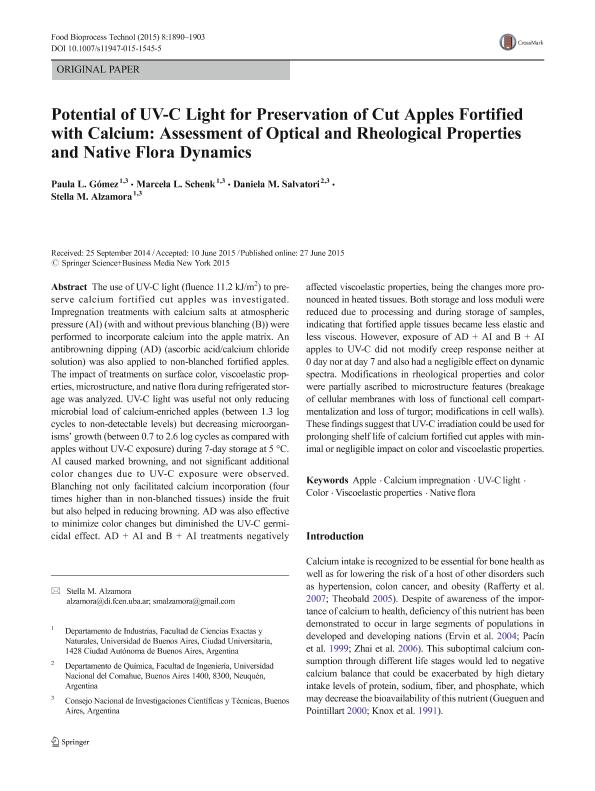Mostrar el registro sencillo del ítem
dc.contributor.author
Gómez, Paula Luisina

dc.contributor.author
Schenk, Marcela Liliana

dc.contributor.author
Salvatori, Daniela Marisol

dc.contributor.author
Alzamora, Stella Maris

dc.date.available
2018-08-13T17:46:17Z
dc.date.issued
2015-09
dc.identifier.citation
Gómez, Paula Luisina; Schenk, Marcela Liliana; Salvatori, Daniela Marisol; Alzamora, Stella Maris; Potential of UV-C Light for Preservation of Cut Apples Fortified with Calcium: Assessment of Optical and Rheological Properties and Native Flora Dynamics; Springer; Food and Bioprocess Technology; 8; 9; 9-2015; 1890-1903
dc.identifier.issn
1935-5130
dc.identifier.uri
http://hdl.handle.net/11336/55155
dc.description.abstract
The use of UV-C light (fluence 11.2 kJ/m2) to preserve calcium fortified cut apples was investigated. Impregnation treatments with calcium salts at atmospheric pressure (AI) (with and without previous blanching (B)) were performed to incorporate calcium into the apple matrix. An antibrowning dipping (AD) (ascorbic acid/calcium chloride solution) was also applied to non-blanched fortified apples. The impact of treatments on surface color, viscoelastic properties, microstructure, and native flora during refrigerated storage was analyzed. UV-C light was useful not only reducing microbial load of calcium-enriched apples (between 1.3 log cycles to non-detectable levels) but decreasing microorganisms’ growth (between 0.7 to 2.6 log cycles as compared with apples without UV-C exposure) during 7-day storage at 5 °C. AI caused marked browning, and not significant additional color changes due to UV-C exposure were observed. Blanching not only facilitated calcium incorporation (four times higher than in non-blanched tissues) inside the fruit but also helped in reducing browning. AD was also effective to minimize color changes but diminished the UV-C germicidal effect. AD + AI and B + AI treatments negatively affected viscoelastic properties, being the changes more pronounced in heated tissues. Both storage and loss moduli were reduced due to processing and during storage of samples, indicating that fortified apple tissues became less elastic and less viscous. However, exposure of AD + AI and B + AI apples to UV-C did not modify creep response neither at 0 day nor at day 7 and also had a negligible effect on dynamic spectra. Modifications in rheological properties and color were partially ascribed to microstructure features (breakage of cellular membranes with loss of functional cell compartmentalization and loss of turgor; modifications in cell walls). These findings suggest that UV-C irradiation could be used for prolonging shelf life of calcium fortified cut apples with minimal or negligible impact on color and viscoelastic properties.
dc.format
application/pdf
dc.language.iso
eng
dc.publisher
Springer

dc.rights
info:eu-repo/semantics/openAccess
dc.rights.uri
https://creativecommons.org/licenses/by-nc-sa/2.5/ar/
dc.subject
Apple
dc.subject
Calcium Impregnation
dc.subject
Color
dc.subject
Native Flora
dc.subject
Uv-C Light
dc.subject
Viscoelastic Properties
dc.subject.classification
Alimentos y Bebidas

dc.subject.classification
Otras Ingenierías y Tecnologías

dc.subject.classification
INGENIERÍAS Y TECNOLOGÍAS

dc.title
Potential of UV-C Light for Preservation of Cut Apples Fortified with Calcium: Assessment of Optical and Rheological Properties and Native Flora Dynamics
dc.type
info:eu-repo/semantics/article
dc.type
info:ar-repo/semantics/artículo
dc.type
info:eu-repo/semantics/publishedVersion
dc.date.updated
2018-08-08T14:16:17Z
dc.journal.volume
8
dc.journal.number
9
dc.journal.pagination
1890-1903
dc.journal.pais
Alemania

dc.journal.ciudad
Berlin
dc.description.fil
Fil: Gómez, Paula Luisina. Consejo Nacional de Investigaciones Científicas y Técnicas; Argentina. Universidad de Buenos Aires. Facultad de Ciencias Exactas y Naturales. Departamento de Industrias; Argentina
dc.description.fil
Fil: Schenk, Marcela Liliana. Consejo Nacional de Investigaciones Científicas y Técnicas; Argentina. Universidad de Buenos Aires. Facultad de Ciencias Exactas y Naturales. Departamento de Industrias; Argentina
dc.description.fil
Fil: Salvatori, Daniela Marisol. Consejo Nacional de Investigaciones Científicas y Técnicas; Argentina. Universidad Nacional del Comahue; Argentina
dc.description.fil
Fil: Alzamora, Stella Maris. Consejo Nacional de Investigaciones Científicas y Técnicas; Argentina. Universidad de Buenos Aires. Facultad de Ciencias Exactas y Naturales. Departamento de Industrias; Argentina
dc.journal.title
Food and Bioprocess Technology

dc.relation.alternativeid
info:eu-repo/semantics/altIdentifier/doi/https://dx.doi.org/10.1007/s11947-015-1545-5
dc.relation.alternativeid
info:eu-repo/semantics/altIdentifier/url/https://link.springer.com/article/10.1007%2Fs11947-015-1545-5
Archivos asociados
